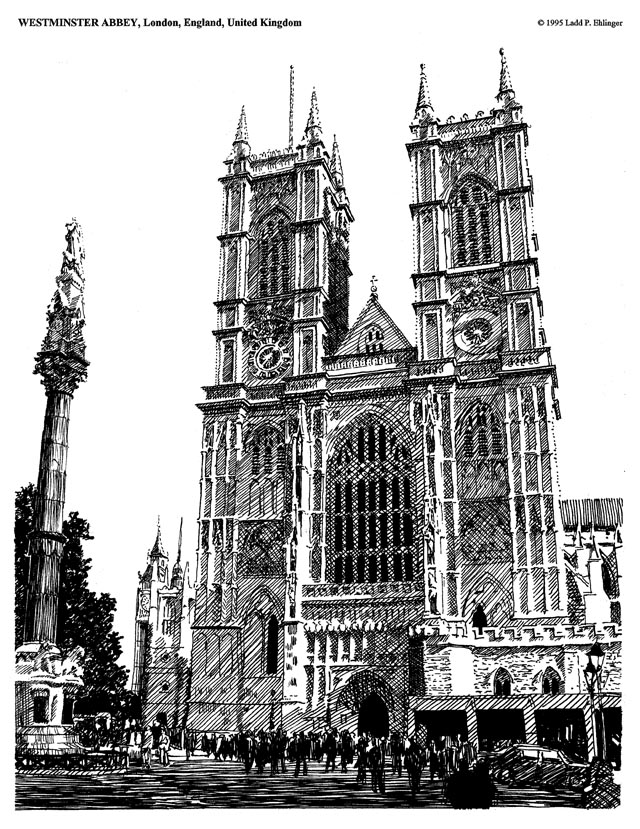
Projects Newsletters Personnel Contact

This issue's limited edition signed print by Ladd P. Ehlinger is of Westminster Abbey, where William the Conqueror was crowned King of England on Christmas Day 1066. All the kings and queens of England since then have had their coronation ceremonies in this ancient church.
The original construction of the Abbey preceded William the Conqueror by approximately 400 years. A church on this site was started by Sebert, a 6th century East Saxon King. Edward the Confessor rebuilt the church in the Norman style with the intention of making it his sepulcher. He died and was buried in it within a week of its completion in 1065.
As to the origin of the name, there is a curious old English inscription in the choir of the present church that begins with: " Westmonastaerie Abbey .." -- all one word. It is the writer's opinion that this may well have been corrupted through time to "Westminster". The Abbey is also on the west side of London. Subsequent monarchs lefi their mark on the Abbey: Henry VI began to rebuild the church in 1220 after being inspired by the Gothic churches at Amiens and Reims. Henry VII constructed his chapel on the east end in 1503-19 in the Perpendicular Gothic style, with beautiful fan vaulting. It was the jewel of its age and perhaps the entire complex.
The upper parts of the west towers, shown in the sketch, were not completed until 1722-45 (well afier the Gothic age), but were designed sympathetically by Sir Christopher Wren and the architect Hawksmoor. Even major repairs by Sir Gilbert Scott have respected the Gothic style of the entire ensemble.
It was Henry VIII who ordered the dissolution of all of the monasteries in 1540 and confiscated all of their property. None of the Abbey churches were destroyed, unlike what the French did during their revolution. Elizabeth I re-established Westminster as a church and College to replace the monastic school. Besides the usual famous and important politicians, statesmen and personages of royalty, Westminster Abbey also has buried and memorials to musicians in a musicians aisle, and poets in the poets corner of the north transept.
One of the poets buried there is Chaucer, who was incidentally the Clerk of the Works during one of the constructions of the Abbey. Statues only of Dryden, John Milton, William Blake, Ben Jonson, Robert Burns, Longfellow and others caused Joseph Addison to remark in the 18th century that "..in the poetical corner I found there were poets who had no monuments and monuments which had no poets".
The granite column in the foreground to the left of the Abbey in the sketch is a monument in-memory of former pupils of the Westminster School who died in the Indian Mutiny and the Crimean War. The tower immediately to the left of the Abbey in the background is the bell tower of Saint Margaret's Church, the church of the House of Commons of Parliament. To the lefi of it, further in the background is Big Ben, the clock tower of the Parliament buildings ensemble. Statistically, the Abbey is 511'-6" long in the EW direction; length of nave 166'; width of nave including aisles 72'; height of nave 102'; height of the west towers to the pinnacles 225'.